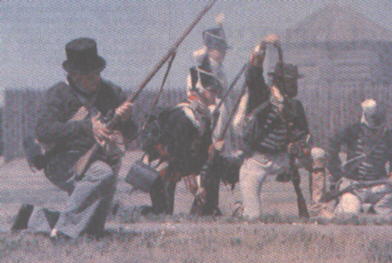


Fort George was awakened by American cannon fire and shells crashing down into it. The commander of the Fort George, Brigadier General John Vincent ordered patrols to go out and watch the river and lakeshore for an American invasion force.
The bombardment of the Fort was becoming very intense. The Americans were using heated shot and one had found it's way into a spot where the fire control parties could not put it out. Soon the entire building was burning.
General Vincent drew some of the force to the riverbank away from the lakeshore. To defend Fort George the British had a company of the 49th Regiment under Captain Ormand and a detatchment of militia Artillery, one hundred and thirty men in all. From Queenston to Four mile Creek there were thirty gunners of the Royal Artillery with five field pieces under Major Holcroft, one thousand and fifty regular infantry, three hundred and fifty militia and fifty Indians.
This force was split into three little brigades. One was commanded by Lieutenant Colonel Harvey, who guarded the river, one brigade under Lieutenant Colonel Myers who guarded the lakeshore, and the third commanded by General Vincent stayed in the fort, ready to support either of the two.
It was now the morning of 27 May, the fort had been under bombardment for two days. There was a thick fog, and the bow of an American ship was spotted out in the thick mist. The alarm was sounded, it was not until the fog lifted that it became clear the lakeshore would be the landing area of the American Force. The only force available to confront the landing was Captain Robert Raunchey's Company of Coloured Men and the Glengarry Light Infantry, it was these units that would meet the first wave of enemy troops. They were reinforced by parts of the Newfoundland Regiment and the 1st Lincoln Militia. After a sharp engagement they were forced to fall back on the 8th Regiment who had moved up in support. General Vincent gave the order to abandon Fort George after suffering 358 casuallties in three hours. They began a slow withdrawl towards Burlington Heights.
The Dragoons were kept busy harassing the advancing American force and running orders between different bodies of troops. On 28 May the army had reached Decew Falls and the Dragoons led by William Hamilton Merritt left from Shipman's Corners (present day St. Catherines) to join the main army there.
Over the next few days, Merritt, in charge of the rear guard, fought a controlled action, ambushing the enemy wherever possible and making stands at the creek crossings forcing the enemy to deploy into line. He would then order a quick volley before moving on. This tactic was repeated at every opportunity costing the Americans precious time in forming back up into marching order to carry on with the pursuit.
He retreated to Stoney Creek arriving there on the 1st of June. For the next week Merritt's Light Dragoons skirmished with the advancing enemy while the main body prepared their defences at Burlington Heights.
Merritt was greatly disturbed by the chain of events that followed the withdrawl from Fort George. He sent a dragoon with orders from Vincent for the force at Chippawa to withdarw through Beaverdams toward Burlington Heights. The militia was sent home and Merritt feared that Vincent was about to abandon Upper Canada altogether.
HISTORICAL NOTES: Heated shot used to bombard Fort George was a very delicate operation for the gunners of the American Artillery. Cannon balls were put into a furnace until they became red hot at which time the ammunition handlers would carry them in an iron cradle to the gun. The cartridge of powder was rammed home and then a wad well soaked in water, was inserted. The glowing ball was then rammed in. Another well soaked wad topped it off, and the gun was fired quickly so the ball would not burn through the first wad blowing up the gun.
Captain Runchey's Company of Coloured Men was made up of escaped slaves who had settled in the peninsula. Many of their descendants live in the peninsula today.